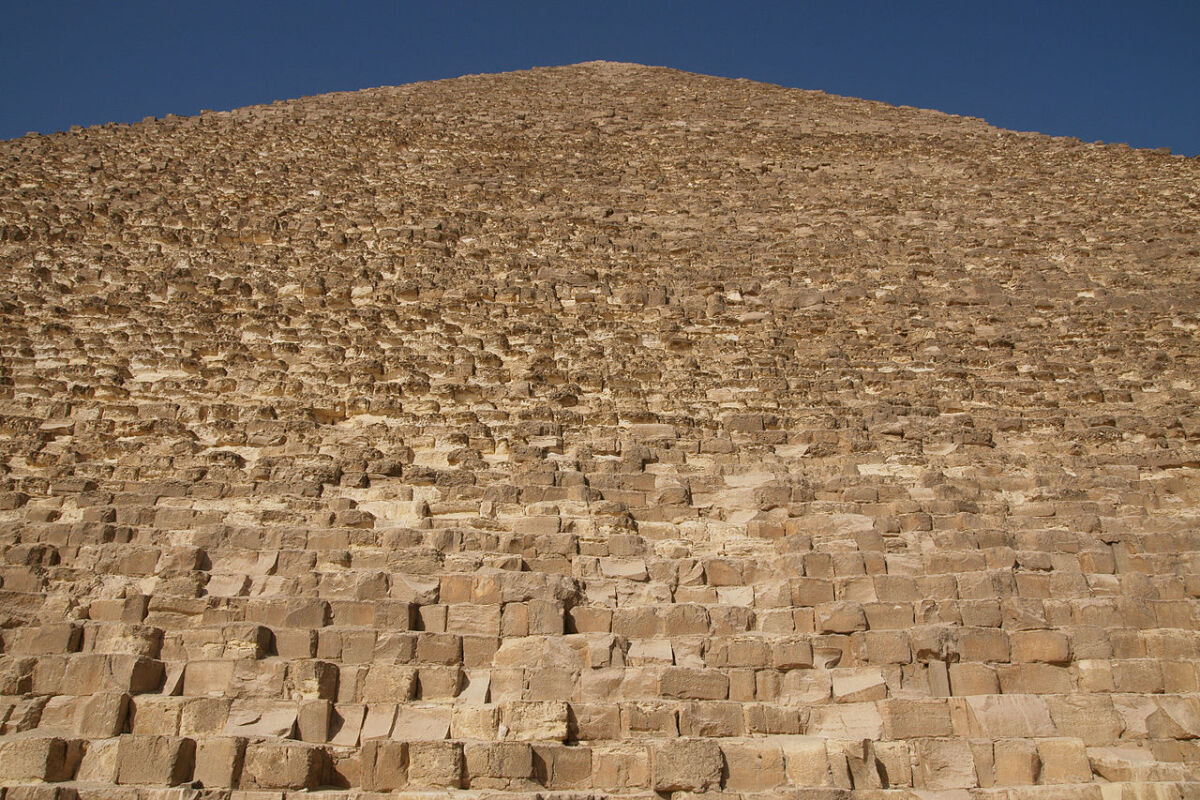It’s one of the most incredible structures on planet Earth—and it has stood so for thousands of years. It’s the only one of the Seven Wonders of the Ancient World that is still intact. Made of nearly 2.5 million blocks of stone, the Great Pyramid of Giza (otherwise known as the “Pyramid of Khufu,” or simply the “Great Pyramid”) weighs in at roughly 6 million tons. Yet for such a gargantuan structure, the structural precision is breathtaking. Stone is laid against stone with knife-edge precision. The pyramid is aligned to “True North” with an accuracy of 0.05 degrees—such accuracy that compasses can be checked against it. With each side of the base measuring 230 meters long, and a height of 147 meters, this behemoth of a structure, while no longer the tallest building on Earth, remains one of the top three heaviest on the planet.
The 19th century author Josephus Augustus Seiss summarizes some of these remarkable details about the pyramid in his 1877 work A Miracle in Stone: The Great Pyramid of Egypt. “[W]e find [in the Great Pyramid] … a perfect geometric figure, so framed that the four sides of its base bear the same proportion to its vertical height as the circumference of a circle to its radius ….” Further, “[t]here is perhaps no much better test of a sound, practical astronomy, than to be able to determine truly the four cardinal points. …
Tycho Brahe’s celebrated Uranibourg observatory is faulty in orientation to five minutes of a degree. The Greeks in the height of their glory could not find the cardinal points astronomically within eight degrees. But the builders of the Great Pyramid, out in the Libyan desert, with no guide or landmark but the naked stars, were able to orient their structure so exactly that the science of the wisest Athenian sages, eighteen hundred years afterwards, was seventy times, and the observatory of Uranibourg nearly four times, further out of the way than it is. (pp. 79, 31)
Yet confusion swirls around this mystical structure—not least about how the near-miraculous level of engineering precision was achieved. The pharaoh who built it is one of the most enigmatic in Egyptian history. Comparatively little is known about him. That which is written about him is either conflicting or downright odd. The pyramid itself doesn’t clear up much confusion: It is strangely empty of the normally ubiquitous Egyptian hieroglyphic inscriptions.
And to those interested in the Bible and the world of biblical archaeology, the Great Pyramid presents another question: Why isn’t such an imposing structure, from a nation that is thoroughly mentioned in the biblical text, accounted for? Numerous other, far less impressive structures around the wider Middle East are mentioned. Why not the Great Pyramid?
Or is it? Is it possible that it is described—but in a manner that has been forgotten over time or largely overlooked?
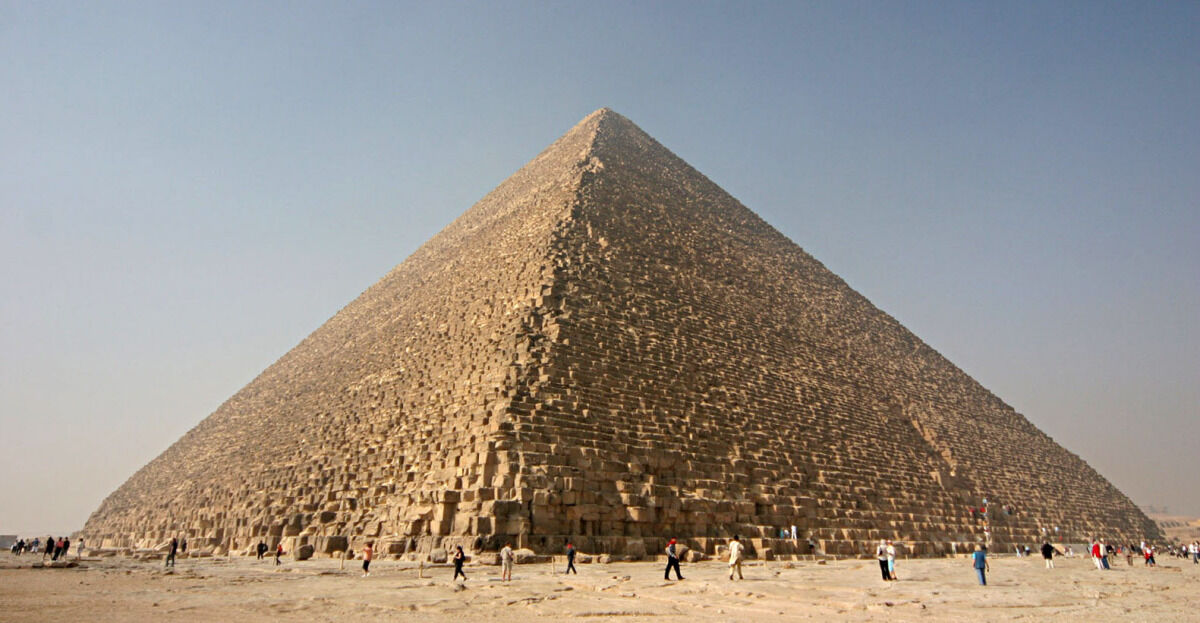
In a May 1964 article in the Plain Truth (the former flagship magazine of our namesake, Herbert W. Armstrong—d. 1986) titled “Who Built the Great Pyramid?”, the late Dr. Herman Hoeh made the case that the Great Pyramid of Giza was built by none other than the biblical figure Job.

A variant theory relating primarily to the biblical patriarch Joseph made headlines in 2017, thanks to comments made by President Trump’s Secretary of Housing and Urban Development, Dr. Ben Carson (a deeply religious individual). Naturally, it elicited media ridicule—it was described as belonging to a world of “unicorns” and “aliens” (The Daily Beast); the theory was derided as “flawed and easily debunked,” and based on a “racist” ideology and “underlying assumption … that it couldn’t have been accomplished by the (usually brown) people who claim to have done it” (courtesy Religion Dispatches; ironic rebuke, considering the theory’s featured proponent, Dr. Carson, is a black individual). One Huffington Post reporter claimed the theory is “repudiated by all Egyptologists.” Both the Huffington Post and Religion Dispatches brought up Dr. Hoeh’s article as another angle in their critiques.
But despite the hot-blooded response by various journalists, what was not highlighted was the overall confusion and unknowns among Egyptologists surrounding the construction of the Great Pyramid and the leader who oversaw its construction. And as for the claim of “racism” against Egyptians: Did you know that the notion of the Great Pyramid being the brainchild of a “different race” comes from an Egyptian source?
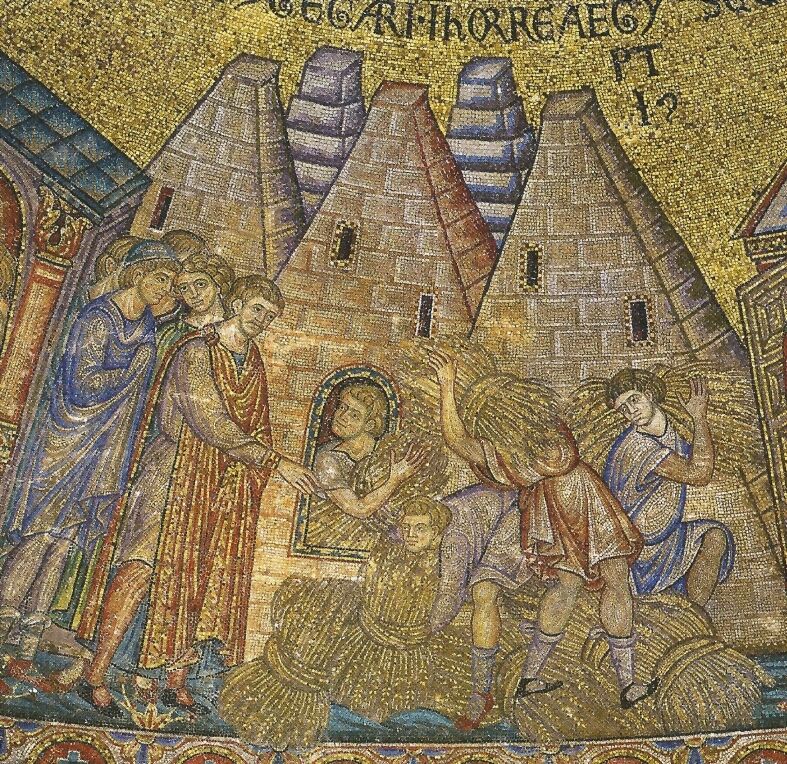
There certainly is no end to the different theories surrounding the Great Pyramid—each with their own various “solutions,” difficulties and problems (including Dr. Carson’s and Dr. Hoeh’s). Even the great inventor Nikola Tesla was obsessed with the pyramids, believing them to have been some sort of transmitting device—and incorporating their shape and even longitudinal placement into his electromagnetic tower designs. From the biblical angle, Dr. Carson’s own belief in the pyramid’s connection with Joseph and his granaries has been around for well over 1,000 years. (For example, as the ninth-century c.e. Patriarch of Antioch, Dionysius i Telmaharoyo, wrote: “We saw in Egypt the pyramids …. They are not the granaries of Joseph, as certain folk have thought.”)
But the association with the enigmatic biblical figure of Job is fascinating, for a multitude of reasons. Are you familiar with the theory? Here’s a journey through the lines of evidence.
A World of Unknowns

For such a domineering edifice as the Great Pyramid, next to nothing is known about the individual who had it made. No statues of this pharaoh have been discovered (or rather, of this king—“pharaoh” was a term primarily used during later Egyptian periods). Only a tiny, palm-sized statuette depicting this ruler has been uncovered—ironically, the smallest royal Egyptian sculpture ever discovered.
Knowledge about this individual and the pyramid built for him primarily comes to us from the classical historians—notably the Greek Herodotus (fifth century b.c.e.), the Egyptian Manetho (third century b.c.e.), and the Sicilian Diodorus (first century b.c.e.). Thanks to the decipherment of Egyptian hieroglyphs in the 19th century, a little more has been gleaned from ancient Egyptian sources, such as the Westcar Papyrus (a later, courtly literary tale that features the king as a main character), as well as certain inscriptions at Giza. Still, relatively little.
And from the accounts available to us, particularly those of the classical historians, we get more questions than answers. Herodotus called this king “Cheops.” Manetho called him “Suphis,” but included a note about Herodotus’s assertion that it was built by a “Cheops”—apparently inferring that Herodotus attributed the structure to an entirely different individual. Diodorus, for his part, called him “Harmais”—although he noted that the Egyptians of his day didn’t seem to know who built it. Various other records called him “Chnoubos” and “Sofe.”
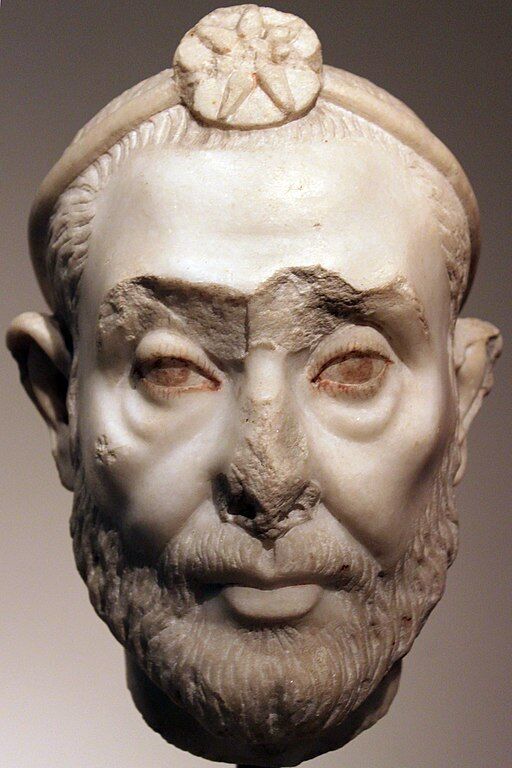
Ancient Egyptian texts ascribe the pyramid to a certain “Khufu.” The Turin King List says that he reigned 23 years. Herodotus gave the pyramid king 50 years of rule. Manetho, 63 years. Yet the highest regnal year thus far discovered on an inscription relating to him attests only up to the 17th year of his reign. With numbers all over the place for this ruler, modern historians variously give him a regnal length of 26 to 46 years.
The first-century c.e. Roman philosopher Pliny the Elder aptly summed it up, writing that the pyramids of Giza “are described by the following writers: Herodotus, Euhemerus, Duris of Samos, Aristagoras, Dionysius, Artemidorus, Alexander Polyhistor, Butoridas, Antisthenes, Demetrius, Demoteles, and Apion. These authors, however, are disagreed as to the persons by whom they were constructed” (Natural History, 36.17).
Another chief issue is the dating of the construction of the Great Pyramid itself (and thus, the reign of the king associated with it). The typical modern conclusion is that it dates to sometime between 2600 and 2500 b.c.e., during Egypt’s Fourth Dynasty. Yet, over less than two centuries of scholarship, this date has varied by thousands of years.
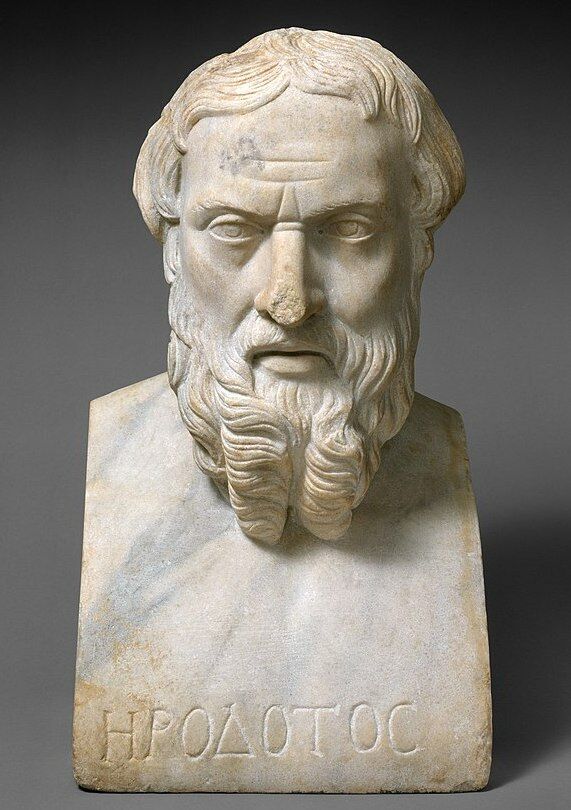
Herodotus and Diodorus both put Cheops/Khufu and his pyramid just following the Ramesside period, sometime just prior to 1000 b.c.e. (Still, Diodorus noted that even during his day, there were claims that the pyramid dated up to some 2,500 years prior to this.) Following their interpretation, 17th-century scholar John Greaves dated the Great Pyramid to 1266 b.c.e. And as late as the 19th century, antiquarian and geologist George Henry Wathen dated it to around 950 b.c.e., mocking claims that it could have been built even 1,000 years prior (as recorded in his 1843 publication, Arts, Antiquities, and Chronology of Ancient Egypt).
But around the same time, in 1835, Sir John Gardner Wilkinson did just that, dating the construction to over 1,000 years earlier—2123 b.c.e. Just 15 years later, Egyptologist Karl Richard Lepsius dated it another 1,000 years earlier, to 3124 b.c.e. Barely 18 years after that, Egyptologist Auguste Mariette dated it more than 1,000 years earlier again, to 4235 b.c.e. The famous 11th edition of Encyclopedia Britannica put the reign of the Great Pyramid’s builder another 500 years earlier again, circa 4700 b.c.e. And even these could be considered the more “conservative” dates: Various pseudoscientific theories by scholars outside the mainstream have since placed the construction of the pyramids up to as early as 13,000 years ago (with one extreme variation placing the construction three times earlier again, in 36,400 b.c.e.)! But from the later decades of the 20th century to today, mainstream dating seems to have more or less settled down to around the mid-2000s b.c.e.
Yet even radiocarbon dating hasn’t been much help on this question (and is a more dubious method than is commonly realized, especially for earlier periods—you can read our article on this subject here). Various samples of wood from the Great Pyramid have been dated: One wood item gave a date up to as early as 3341 b.c.e.; another was dated up to as late as 2484 b.c.e.
Then there is the debate about how the pyramid was built (see one good theory in the video above). Various classical historians asserted that it must have been on the backs of slaves. Yet based on the overall perfection, integrity and quality of the structure itself, early Egyptian texts, and archaeological remains showing the workers were well-fed and housed, that theory of slave-labor has now largely been debunked.
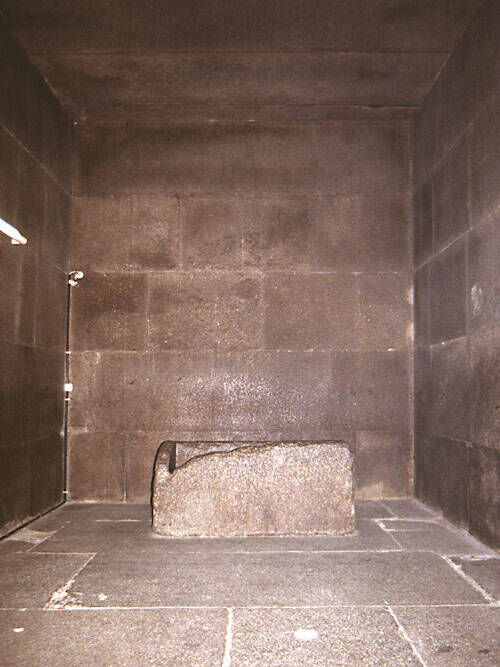
Yet besides the general mystery of how is the mystery of why. Why was the Great Pyramid constructed (or the Egyptian pyramids at all, for that matter)? Pyramids are not at all ubiquitous structures throughout Egypt’s history. The most famous pyramids—the Step Pyramid, the Red Pyramid, the Bent Pyramid, the Great Pyramid of Khufu, the Pyramid of Khafre (Khufu’s son), the Pyramid of Menkaure (Khafre’s son), and their smaller satellites—were all built over roughly a single-century window of time, deep in Egypt’s past. What, exactly, was their overall purpose? Why the design? Was the Great Pyramid simply a tomb? There is a key theory that Khufu was never even buried in the pyramid (as attested, for example, by Herodotus) and that the “tomb” chamber was never properly completed as such. Indeed, no remains or grave goods have been found in what is believed to be the burial crypt. Was this the result of tomb robbery? Or was the king never really buried there?
Also, thanks to new technology (in the form of muon scanning, completed in 2017), we now know that there are more chambers buried within the Great Pyramid that have yet to be explored: two in particular, one of them an exceptionally large void within the upper part of the structure, estimated to be 30 meters long and 6 meters high. What does it contain? Is there a way to access it?

And here’s something to really make you question everything you know: Did you know that the Great Pyramid does not have four sides? Technically, it is eight-sided; each of the four main faces are actually made up of two angles, joined down the center (largely invisible from the ground, but viewable from the air). Again, why?
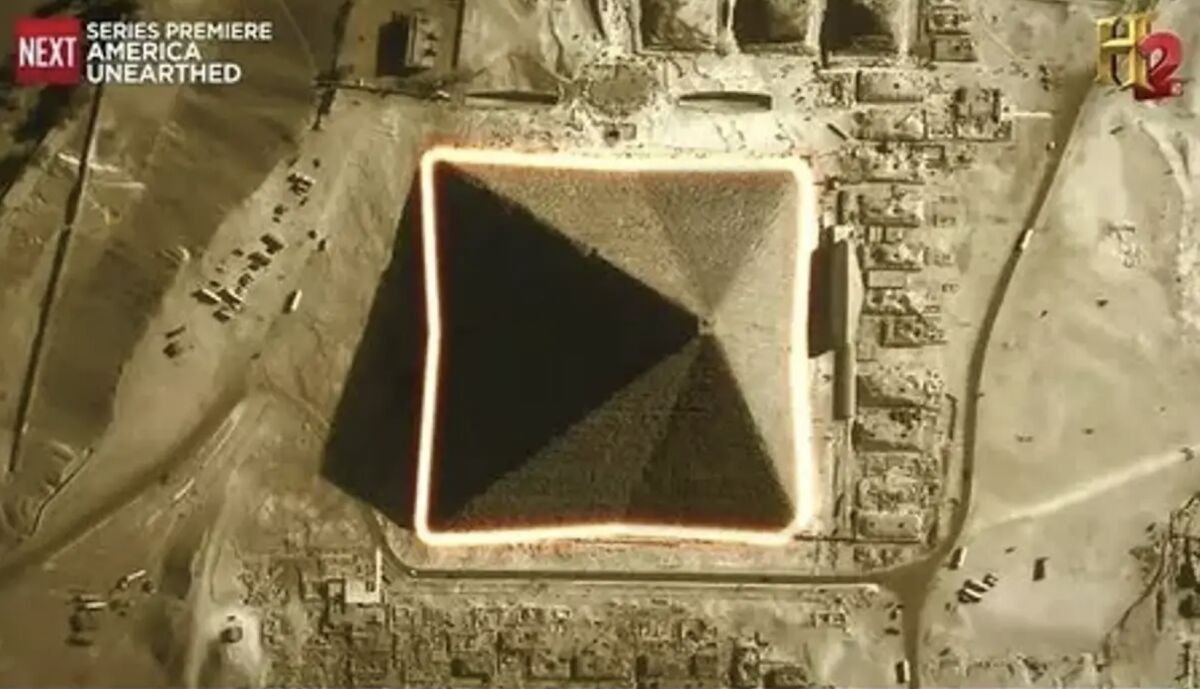
The plot thickens.
No Ordinary Egyptian King
Manetho asserted that the kings of the Fourth Dynasty (of whom there were six, Khufu being second and most significant among them) were people dwelling in Memphis “of a different race” (as relayed in Wathen’s Arts, Antiquities, and Chronology of Ancient Egypt, pg. 54—he continued to expound on how they were a “hated race” by the Egyptians). This “different race” statement by Manetho introduces his summary of Suphis/Khufu, and it is a unique remark made by him of no other Egyptian dynasty.
Interestingly, the classical historians also noted that this leader stopped the polytheistic worship occurring around Egypt at the time. Herodotus, in his Histories (2.124, 128), noted the following about this individual (again, whom he referred to by the name Cheops):
Cheops became king over them and brought them to every kind of evil: for he shut up all the temples, and … kept them from sacrificing there. Thus, they reckon that for 106 years Egypt was in great misery and the temples so long shut were never opened. The people [Egyptians at the time of Herodotus] hate the memory of these two kings [Cheops/Khufu and his son, Khafre] so much that they do not much wish to name them.
Beyond the shutting of temples, it is also theorized that this ruler may have even banned the making of statues—given the overall lack thereof relating to him (excepting the above small statuette, the dating of which itself is still, like the very pyramid, highly debated—varying up to as much as 2,000 years following the reign of Khufu).
The third-century b.c.e. Manetho (who, as an Egyptian priest-historian, had greater access to Egyptian records than did the traveling Greek historian Herodotus) provided further detail. In describing this king as “belonging to a different royal line,” he wrote the following: “Suphis, the builder of the Great Pyramid, which Herodotus says was built by Cheops. Suphis conceived a contempt for the gods, but repenting of this, he composed the Sacred Book” (Frag. 15). Or, as preserved through early Armenian texts (note that Manetho’s original text has been lost and is only preserved through fragments or secondary accounts): “Suphis behaved arrogantly towards the gods themselves: then, in penitence, he composed the Sacred Book.”
The identity of this “Sacred Book” is a real puzzle. But this statement by Manetho happens to be the entire pretext of the sacred biblical book of Job.
Job—the ‘Greatest Man of Antiquity’
Much like Khufu and his pyramid, the book of Job is an enigma. This is chronologically considered to be the earliest book of the Bible. There is no mention of Israel, Moses, an Exodus or even the Israelite patriarchs. It represents an early period in which sacrifices were evidently still permissible from separate locations and by non-Levites (e.g. Job 42:8). Yet there is apparent reference to the Flood (Job 22:15-17). As such, the setting is apparently “post-Flood” but still at a very early period in time, probably the “early patriarchal era,” as noted by Craig Davis in his book Dating the Old Testament. The 17th century theologian and academic Dr. John Owen, in his Theologoumen, assigns Job to the period just prior to Abraham. The above-quoted Joseph Seiss, to the “pre-Abrahamic age of Serug, Reu, and Peleg” (A Miracle in Stone, pg. 84). Whatever the case, the general clues from within the book places it chronologically earlier than the Torah (written by Moses) and the other books of the Hebrew Bible.
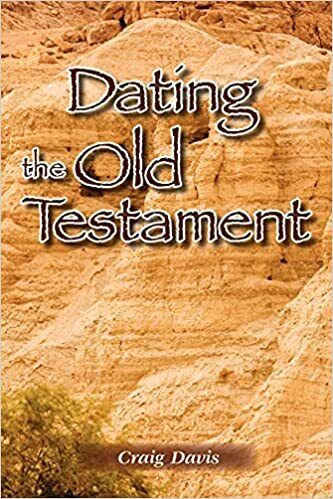
Further, the book of Job is believed by many to be a translation into Hebrew from an original text of another language, based on certain peculiarities throughout. Davis, who explains them in his book, summarizes: “Job is distinctively non-Israelite in nature, saying nothing about the land of Israel, the people and history of Israel, or the religious practices in Israel. The names of Job and his friends are not Israelite names. This … hints at a non-Israelite origin for the book. If the book’s origin was not within Israel, the original language would likely not be Hebrew.”
The book of Job introduces the protagonist in no uncertain terms: “[T]his man was the greatest of all the men of the east” (Job 1:3). The word “east” here can mean exactly that—but it is also the same word for “ancient times” or “antiquity.” Thus, it can be just as accurately translated “this man was the greatest of all the men of antiquity.” (And this may well be the better translation, as other words are used in Job to describe “east” directionally.)
Naturally then, this “greatest man of antiquity” is characterized as a powerful leader and a king. “I [Job] … sat as chief, And dwelt as a king …” (Job 29:25). “Unto me men gave ear, and waited, And kept silence for my counsel” (verse 21). “The young men saw me, and hid themselves, And the aged rose up and stood; The princes refrained talking, And laid their hand on their mouth; The voice of the nobles was hushed, And their tongue cleaved to the roof of their mouth” (verses 8-10). Apparently he was also endowed with “flattering titles” (Job 32:21-22). Job 19:9 mentions Job’s “glory” and the “crown” upon his head. God Himself praises the greatness of Job: “Hast thou considered My servant Job, that there is none like him in the earth …?” (Job 1:8, 2:3). Job also mused on his death and entombment in royal terms: “[T]hen [would I have] been at rest—With kings and counsellors of the earth …” (Job 3:13-14).
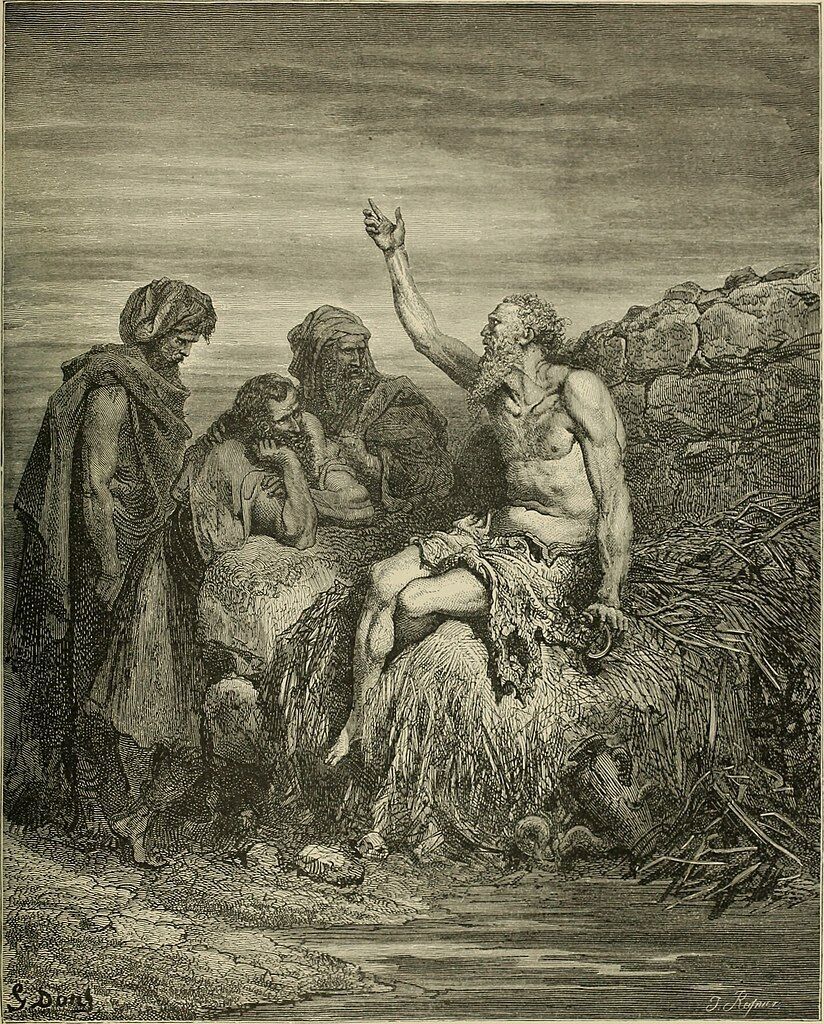
The book of Job is the account of a certainly righteous, yet deeply self-righteous, arrogant man who ultimately esteemed himself more righteous and perfect than God. Following a series of disasters that befell him, wiping out his prosperity, killing his children and leaving him diseased (covered in boils—chapters 1-2), Job’s true character was revealed in a series of conversations between himself and his three friends (chapters 3-31). Job described himself as “righteous,” “pure” and irreproachable (Job 29:14; 16:17; 27:6), eventually holding God in contempt as “cruel” and “mine adversary” (Job 30:21; 31:35). “Oh that I knew where I might find him! that I might come even to his seat! I would order my cause before him, and fill my mouth with arguments” (Job 23:3-4). “[L]et me alone, that I may speak, And let come on me what will” (Job 13:13).
Finally, following the damning counsel of Elihu (chapters 32-37) and God Himself (chapters 38-41), Job was ultimately humbled, cut down to size, and brought to repentance (chapter 42). Following this, he was blessed with another family and double the vast wealth he started out with (Job 42:10-17).
As one of Job’s friends described him: “[H]e hath stretched out his hand against God, And behaveth himself proudly against the Almighty” (Job 15:25). Yet by the end of the book, Job had repented: “Therefore have I uttered that which I understood not, Things too wonderful for me, which I knew not. … Wherefore I abhor my words, and repent, Seeing I am dust and ashes” (Job 42:3, 6). Job also highlighted his desire that his plight be recorded. “Oh that my words were now written! oh that they were printed in a book! That they were graven with an iron pen and lead in the rock for ever!” (Job 19:23-24; King James Version).
What was it that Egyptian priest-historian Manetho wrote of the builder of the Great Pyramid? That he behaved arrogantly toward the gods themselves, but repenting of this, composed a Sacred Book.
Coincidence? Perhaps. But there are other remarkable details throughout the book of Job that are easily missed. For example, did you know that an underlying theme in the book of Job is grand construction?

A Constructional Comparison—But to What?
Job 38-41 contain God’s personal rebuke of Job, where He asserts His vast superiority. This rebuke includes a continuous theme of grand building and construction—the apparent inference being that Job was highly esteemed in this manner. After all, though his work paled in comparison to God’s, he was still the “greatest of all the men of antiquity.”
“Then the Lord answered Job from the whirlwind: “Who is this that questions my wisdom with such ignorant words? … Where were you when I laid the foundations of the earth? Tell me, if you know so much. Who determined its dimensions, and stretched out the surveying line?” (Job 38:1-2, 4-5; New Living Translation).
“Who kept the sea inside its boundaries …? For I locked it behind barred gates, limiting its shores” (verses 8-10; nlt). “Hast thou surveyed unto the breadths of the earth?” (verse 18). “Hast thou commanded the morning[?]” (verse 12). Job’s companion, Elihu, reprimanded Job in the same vein: “Dost thou know the balancings of the clouds …? Canst thou with him spread out the sky …?” (Job 37:16, 18). “Yea, can any understand the spreadings of the clouds, The crashings of His pavillion?” (Job 36:29).
God continues: “Whereupon were the foundations [of the Earth] thereof fastened? Or who laid the corner-stone thereof, When the morning stars sang together, And all the sons of God shouted for joy?” (Job 38:6-7).
Pyramids Aren’t Mentioned in the Bible—Right?
In his aforementioned article, Dr. Hoeh credited our namesake, Herbert Armstrong, for highlighting this potential link between Job and the construction of the Great Pyramid. Mr. Armstrong (who himself visited the pyramid a number of times) expounded on the above scripture, Job 38:7, in one of his early radio broadcasts on the subject of Job—particularly as it relates to the Great Pyramid’s capstone (or, pyramidion). “One point about [pyramids] that is most interesting, is this: It’s the only type of building, that I know of, the only building that I’ve ever heard of on Earth, where the cornerstone is the top stone, and is laid last.” He continued:
[It] signified the very completion of the building. The cornerstone there is on top. And it is a corner—you know, you have the four corners of the bottom, but you have the corner at the top, too, at the apex, where they all meet. …
“And all the sons of God shouted for joy” as the final corner stone was laid on this Earth. Now that’s all figurative language, of course. There isn’t any actual cornerstone on the Earth. He’s comparing it to a building. It’s being compared to a building on this Earth, where the cornerstone is the final capstone, the completing stone that is laid last. …
And, strangely enough, if there is a symbolism to the Great Pyramid, that top cornerstone seems to be referred to in the Bible as the “stone which the builders rejected, that has become the head of the corner”—in King James Bible language—which means the head cornerstone, the top cornerstone [quoting Psalm 118:22].
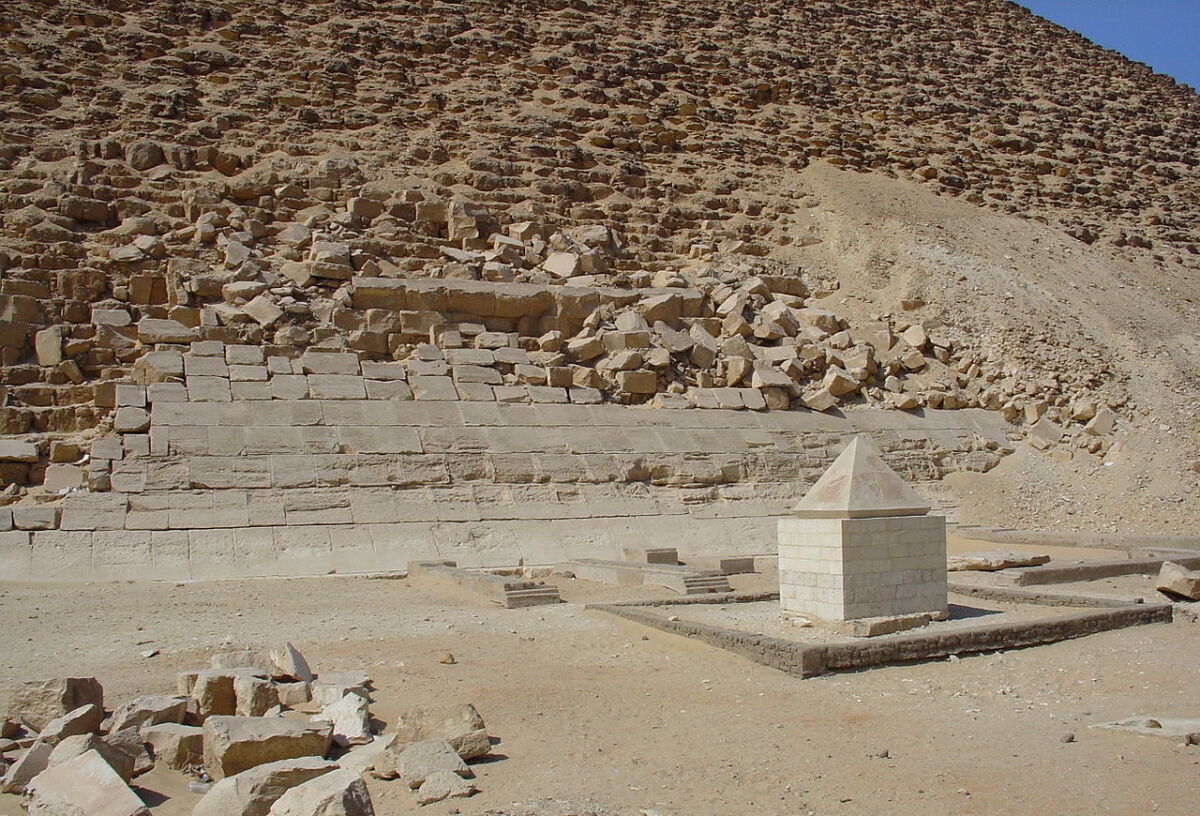
These clues further point to a wider possibility: Are pyramid structures, or shapes, mentioned in the Bible? Scriptures such as Psalm 118:22 may indeed reference them.
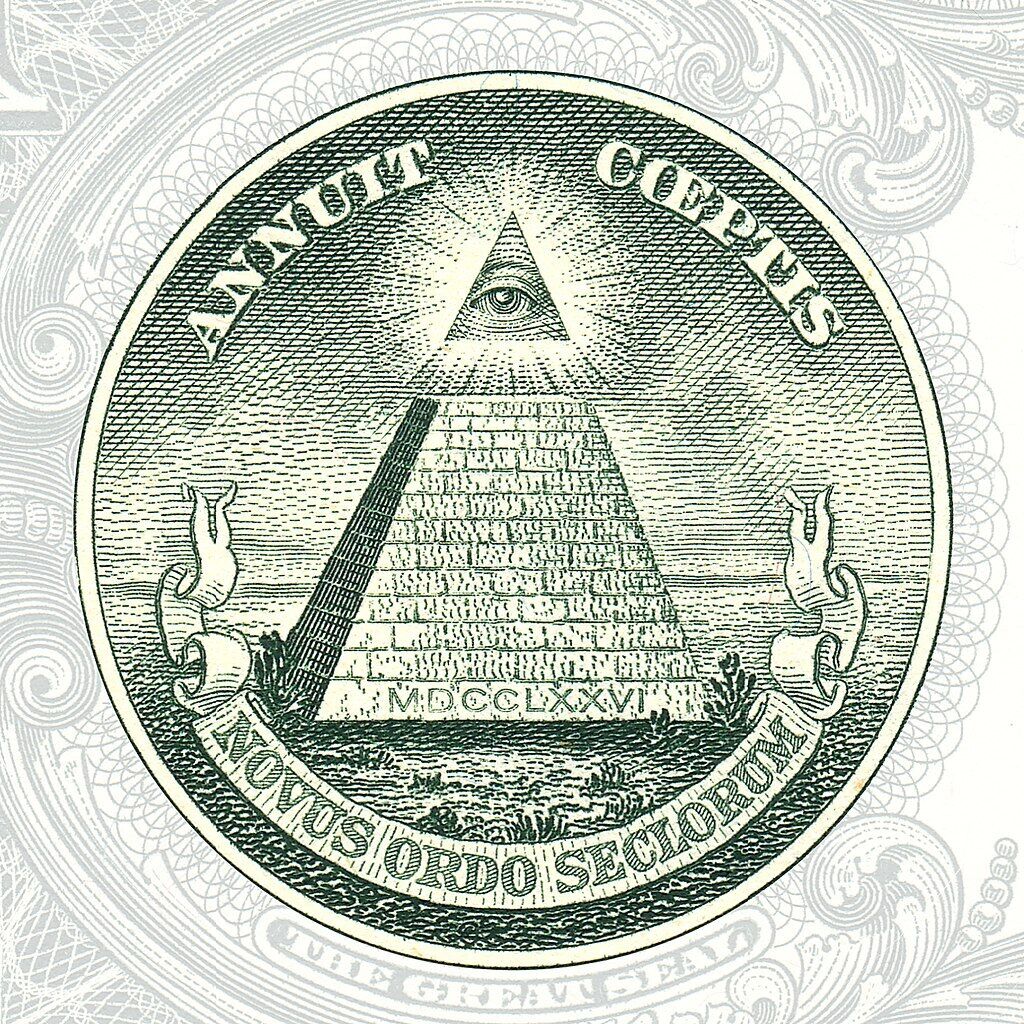
Triangles, or pyramids, have long been associated with top-down government structure. To that end, there are biblical hints at future Jerusalem, as capital of the world, being described in such a manner. Various scriptures cite this future city of the World to Come as being like a “mountain” (e.g. Isaiah 2:2). The New Testament goes even further, presenting it as an enormous four-sided city-structure as tall as it is wide. “[N]ew Jerusalem, coming down from God out of heaven … lieth foursquare, and the length is as large as the breadth: and he measured the city with the reed, twelve thousand furlongs. The length and the breadth and the height of it are equal” (Revelation 21:2, 16). This has sometimes been interpreted as a cube-shaped edifice, yet has also just as often been interpreted as a pyramid, particularly in light of scriptures referring to future Jerusalem as a “mountain” in shape, as well as the fact that such a structure has a parallel layout to top-down, theocratic government.
And what about biblical words that we don’t know for certain—words that may not be properly understood or translated, that could reference such pyramid structures? The book of Job is unique in that it contains the greatest percentage of hapax legomena of all the books in the Hebrew Bible. A hapax legomenon is a word that is only found once in a source—as such, these words can often be difficult to understand or translate, as over time their meaning is easily lost. The book of Job contains nearly 150 of them—and a full 60 are completely without derivation from any known biblical root words. (As a side note, the circa second-century b.c.e. Greek Septuagint translation of the book of Job is some 400 lines shorter than the Hebrew—one theory for this is that the translators became so frustrated with the book’s complex language that they simply gave up!)
Is it possible that more direct reference to the Great Pyramid could be buried in the still somewhat vague, complex language of this peculiar book?
The Great Pyramid = ‘The Rock’?
There are indeed numerous unusual statements throughout the book of Job that various translations make attempts at interpreting. Among them are statements that relate to some kind of worry about removable landmarks, preservation in death and the permanency of “the rock.” What could this be referring to?
Job 5:23-24 contain an assurance from one of Job’s friends that he would be “in league with the stones of the field …. And thou shalt know that thy tabernacle shall be in peace” (kjv). Yet Job 14:18-19 contain Job’s fear that “surely the mountain falling crumbleth away, And the rock is removed out of his place; The waters wear the stones.” Also, “[t]here are [those] that remove the landmarks” (Job 24:2). One of Job’s friends stated: “Thou tearest thyself in thine anger, Shall the earth be forsaken for thee? Or shall the rock be removed out of its place?“ (Job 18:4, kjv). Job replied: “Oh that my words were now written … That with an iron pen and lead they were graven in the rock for ever!” (Job 19:23-24).
Could this “rock” be a veiled reference to the Great Pyramid? Certainly, with the Great Pyramid of Giza, we have one of history’s most enduring, immovable, monumental landmarks—a record in stone, “for ever.”
Job even mused about his death in such terms of enduring preservation: “Then I said, I shall die in my nest, and I shall multiply my days as the sand” (Job 29:18; kjv). The self-pitying Job states further: “I would now be at peace. I would be asleep and at rest. I would rest with the world’s kings and prime ministers, whose great buildings now lie in ruins. I would rest with princes, rich in gold, whose palaces were filled with silver” (Job 3:13-15; nlt).
This is another theme addressed by the book of Job: No matter the grandeur of the individual (or the grandeur of their mortuary complex!—if that is indeed what this is), the rich and poor die the same way.
Job’s Religious Struggles
A key point asserted by Herodotus is that this builder of the Great Pyramid caused a religious earthquake among the polytheistic Egyptians: He “shut up all the [Egyptian] temples.” At face value, of course, this could be seen as reflective of a God-fearing, monotheistic Job. But the book of Job itself describes his fight to uphold proper worship of God, Elohim—even among his own wife and children.
“And it was so, when the days of [his children’s] feasting were gone about, that Job sent and sanctified them, and rose up early in the morning, and offered burnt-offerings according to the number of them all: for Job said, It may be that my sons have sinned, and renounced God [Elohim] in their hearts. Thus did Job continually” (Job 1:5; American Standard Version). Job’s wife notably called out his religious devotion when his trials began: “Then said his wife unto him, Dost thou still hold fast thine integrity? renounce God [Elohim], and die” (Job 2:9; asv).
Job 21 contains the musings of Job on this subject: “[T]he wicked … said unto God [El]: ‘Depart from us; For we desire not the knowledge of Thy ways. What is the Almighty [Shaddai], that we should serve Him? And what profit should we have, if we pray unto Him?’” (verses 7, 14-15). According to Job, the wicked thought, Why should we concern ourselves with Elohim/El/Shaddai? Leave us to our own gods. This statement is similar to that of the later Egyptian pharaoh at the time of Moses. “And Pharaoh said: ‘Who is the Lord, that I should hearken unto His voice …?” (Exodus 5:2).
Another entirely separate biblical passage mentions Job, alongside two other men, as an example of righteousness among Gentile, sinful surroundings. Ezekiel 14 reads: “[T]hough these three men, Noah, Daniel, and Job, were in [this certain location], they should deliver but their own souls by their righteousness, saith the Lord God. … [T]hough Noah, Daniel, and Job, were in it, as I live, saith the Lord God, they shall deliver neither son nor daughter; they shall but deliver their own souls by their righteousness …” (verses 14, 20). What kind of pagan setting, then, must Job have been in? This isn’t the thrust of the book of Job—but it is interesting, nevertheless, to speculate.
And it is interesting, again, to compare this to the Great Pyramid itself. In the words of Seiss:
And yet, here is the Great Pyramid, the largest, finest, and most wonderful edifice in all Egypt, situated in the midst of an endless round of tombs, temples, and monuments, all uniformly loaded down with these idolatrous emblems and inscriptions, and yet in all its thirteen acres of masonry, in all its long avenues, Grand Gallery, and exquisite chambers, in any department or place whatever, there has never been found one ancient inscription, votive record, or the slightest sign or shred of Egypt’s idolatry! In the centre of the intensest impurity, the Great Pyramid stands without spot, blemish, or remotest taint of the surrounding flood of abominations … (ibid, pg. 81)
Enter ‘the Shepherd’
There is another enigmatic statement made by Herodotus—one that potentially fits with Manetho’s reference to the pyramid builders as being of “a different race,” hinting at a foreign derivation—which provides another possible link to Job.
Herodotus wrote: “The [Egyptian] people hate the memory of these two kings so much that they do not much wish to name them, and call the pyramids after the shepherd Philitis, who then pastured his flocks in this place” (Histories, 2.128). Who was this shepherd? What does this enigmatic assertion by Herodotus even mean? Again, theories abound.
Was this a reference to a region owned and operated by a shepherd at the time of the construction of the pyramids, with whom its construction was, at least in part, affiliated? In A. D. Godley’s translation of Herodotus’s Histories into English, it is speculated in his footnote that this is a reference to the “rule of the ‘shepherds’ (Hyksos) in Lower Egypt, perhaps from 2100 to 1600 b.c.” Josephus, for his part, identified these “Hyksos,” or “shepherd kings,” as none other than the biblical Israelites themselves, who descended into Egypt at this time (Against Apion, Book 1.14). He also credited the Israelites with building pyramids during their stay in Egypt (Antiquities, 2.9.1).
Wathen, in his 1839 publication, likewise addressed this then-common link to Herodotus’s statement about the Hyksos “shepherd race,” the explanation by Josephus about them, and their relation to the building of the pyramids. (For his part, Wathen dismissed this Israelite theory as “arguments utterly insufficient,” based on his belief that the pyramids had to be far younger than this patriarchal/sojourn period!)
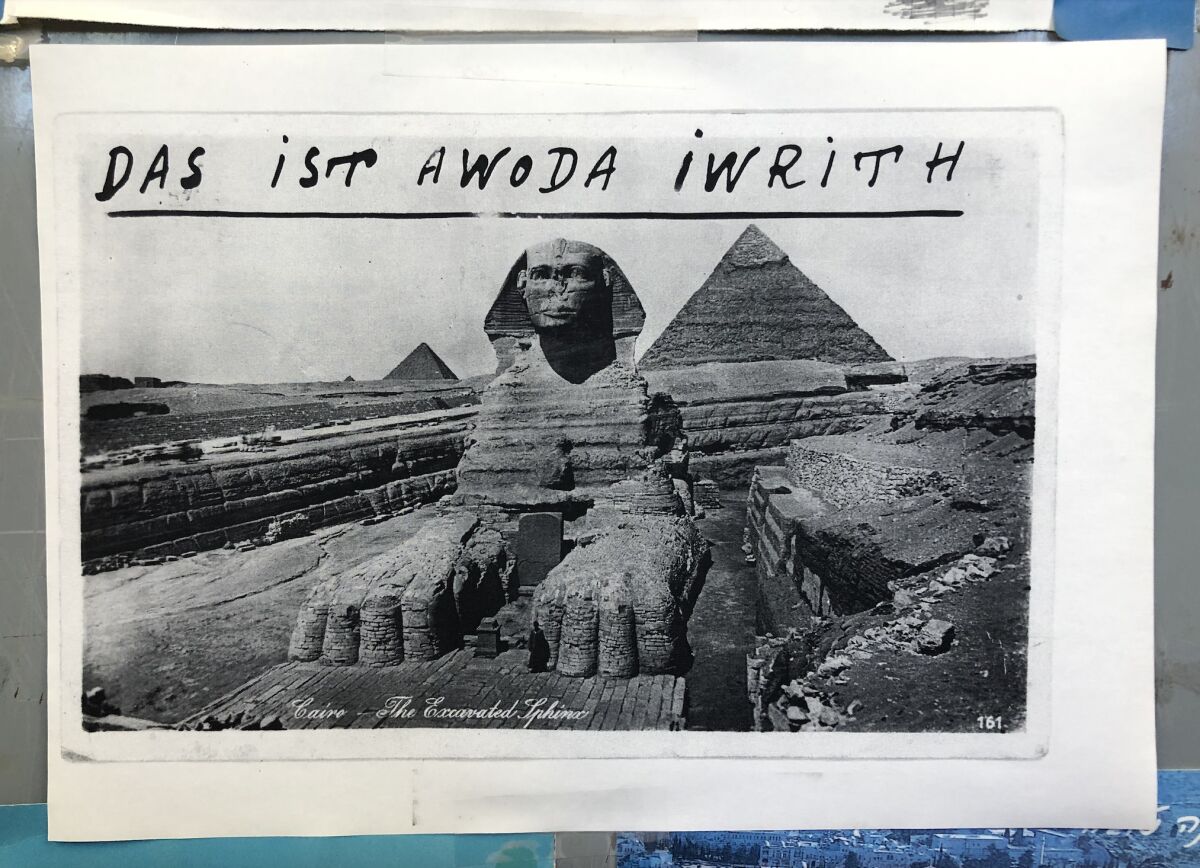
As this Ancient Architects episode asks, could the name Philitis be a reference to the general region of Palestine/Philistia and the Hebrew shepherds that hailed from there—an area that could conceivably include the southern regions highlighted in the Book of Job, of Edom/Teman? And could it be another link to the “different race” of the pyramid-builder and his dynasty? After all, as the Bible reveals, “every shepherd is an abomination unto the Egyptians” (Genesis 46:34).
In his book Exploring Ancient History, Roy Schultz points out that this same chapter of the Bible also describes a “Job” as one of the early Israelite patriarchs, quoting Genesis 46:8 and 13: “And these are the names of the children of Israel, who came into Egypt, Jacob and his sons … and the sons of Issachar; Tola and Phuvah, and Job, and Shimron” (verses 8, 13). Dr. Hoeh draws attention to the same passage. The name Job here is actually spelled slightly differently in Hebrew to the name in the Book of Job (see also 1 Chronicles 7:1), so it can be argued that it refers to a different individual entirely (but more on this further down).
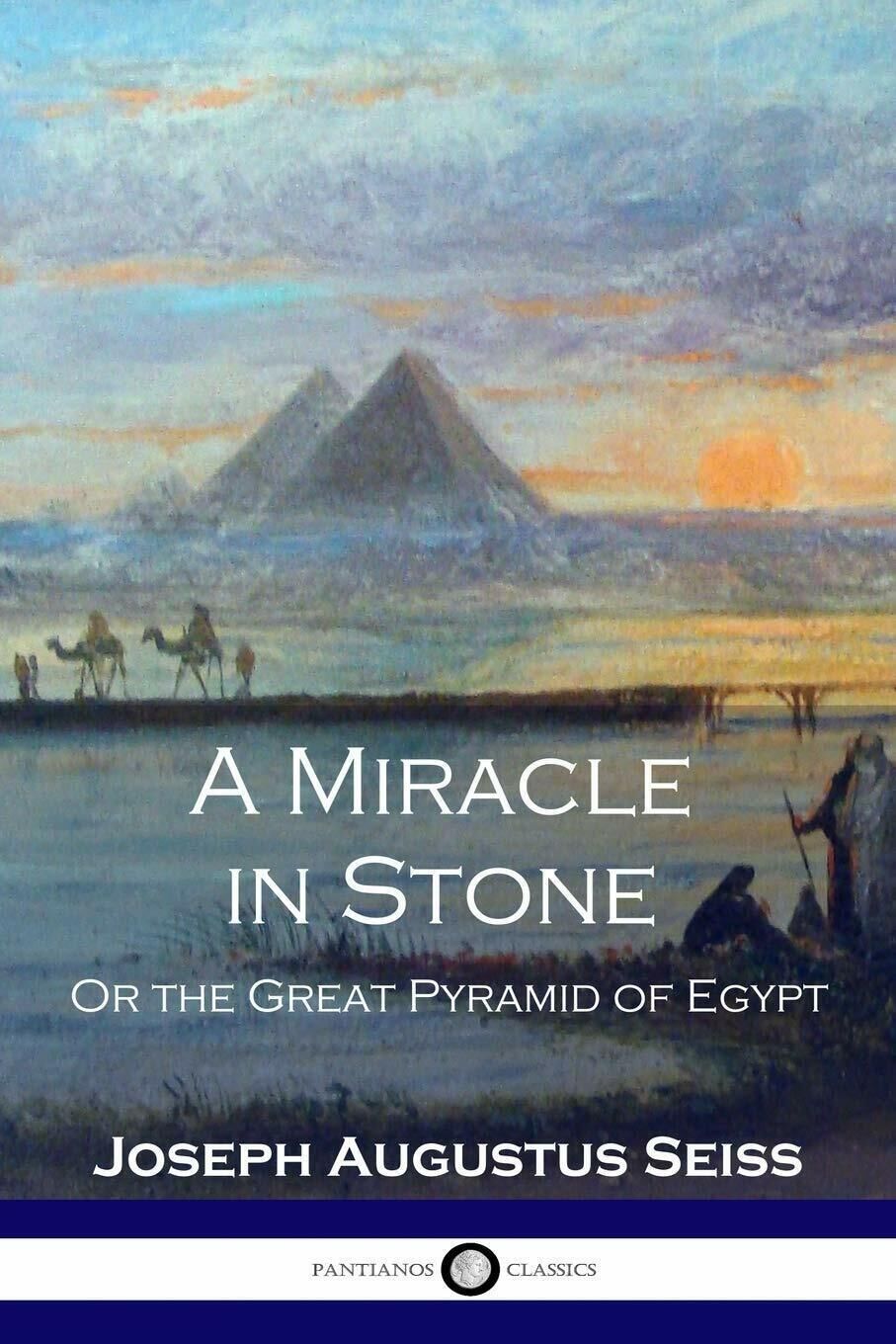
Job has also been variously posited as the Jobab of Genesis 10:29—a pre-Abrahamic descendant of Shem. The abovementioned Seiss (who in his book A Miracle in Stone likewise identifies the Great Pyramid builder as being Job) notes about this individual Jobab: “The seventy translators from tradition [Septuagint], most of the Hebrew authors, Origen, the Coptic version of Job, the Greek fathers, and various modern writers, represent Job-ab and Job as one and the same. In that case we would here have a Job, a veritable Arabian, a descendant of Eber (through Joktan, as Abraham through Peleg), and hence a true Hebrew in the older and wider sense …” (ibid, pg. 85).
Whatever the case—whether Job is to be identified as the son of Issachar, the patriarch Jobab, or someone else entirely—the Book of Job itself does describe the protagonist as an incredibly wealthy “shepherd.” Job is described as possessing a combined total of 14,000 sheep, 6,000 camels, 2,000 oxen, and 1,000 donkeys at a single point in time (Job 42:12)—not to mention the many additional thousands of livestock he owned throughout his lifetime (note Job 1). Could Herodotus’s mention of the then-Egyptian association of the Great Pyramid with “the shepherd” therefore be another positive identification of the biblical Job and his vast flocks?
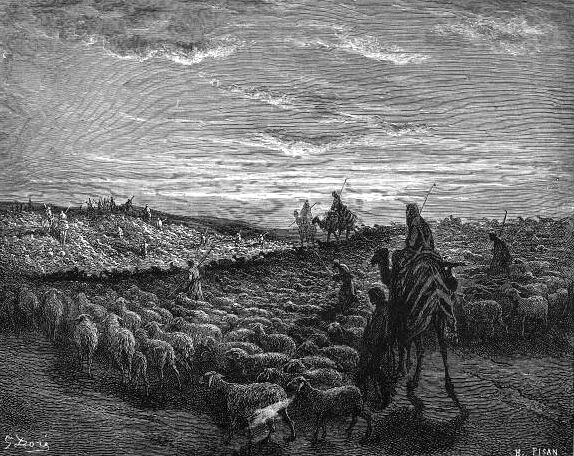
Additional Details
Let’s take a step back, to examine the geographical setting. The primary setting of the book of Job is in the mysterious “Land of Uz.” Clues suggest a primary eastern emphasis and location (perhaps constituting territory in or around Edom or western Arabia), indicating that Job was a man of eastern derivation. (There are also various regional traditions of Job from as far away as Oman in the south to Turkey in the north.)
That being said, as Prof. Choon-Leong Seow notes in his commentary Job 1-21, the author “seems to know something about Egypt, as the reference to swift reed-skiffs (9:25) [Egyptian craft made from papyrus], the mythology of a watery monster associated with darkness, a creature known in Egypt as Apep, and the allusions to Leviathan … all attest.” He continues: “There are also surprisingly frequent mentions of ice (6:16; 37:10; 38:29), snow (24:19; 37:6; 38:22), and frost (38:29) [something that would not generally be expected from an Arabian setting]. … [T]hese allusions … indicate the cosmopolitan background of the book.” Seow notes other Egyptianisms in the text, including loanwords (i.e. the “reeds” and “rushes” of Job 8:11. Naturally, though, if the book represents a largely Hebrew translation from an original language, many such connections will be lost).
As for the emphasis on an Arabian origin, Herodotus also made a connection to the region in his description of the building of the Great Pyramid. He stated that workers “were appointed to draw stones from the stone-quarries in the Arabian mountains to the Nile” (ibid.). Diodorus stated the same—that the blocks were brought from Arabia.
But beyond its more immediate setting, the book of Job does demonstrate an overall wide geographical scope of knowledge. It contains mention, directly or indirectly, of Ethiopia, Sheba, Chaldea (Babylon) and Teman (Edom), among others—as well as mention of the faraway bounds of the Earth. (Job even describes the Earth and atmosphere in circular terms in Job 22:14 and 26:10, arguably reflecting an early knowledge of the spherical nature of the planet.)
Dr. Hoeh noted of the Egypt-Arabian connection, in relation to Khufu/Cheops: “Cheops has another name—Saaru of Shaaru (Petrie’s History of Egypt, vol. i, p. 37). Saaru is another name ‘for the inhabitants of Mt. Seir’ (Rawlinson’s History of Egypt, ch. 22).” Dr. Hoeh explained:
Mt. Seir was famous in history as the “Land of Uz” (Vol. iii of Clarke’s Commentary, preface to Book of Job). Uz was a descendant of Seir the Horite (Gen. 36:28). The Arabs preserve a corrupt record of Cheops of Mt. Seir or of the Land of Uz. They call him the “wizard of Oz.”
Dr. Hoeh, for his part, offered that the very name of Khufu/Cheops can be connected with the name Job (a name pronounced in modern Hebrew as ‘Yeov, and which also can be transliterated as ‘Yeob). The first Hebrew letter of Job’s name is a guttural consonant that apparently would have originally had a more recognizable sound (but that has since become a silent letter in modern Hebrew). By the same token, the names Khufu and Cheops are not pronounced with the hard K sound we associate with them today—rather, the guttural Ḥ: Ḥufu, Ḥeops, or Ḥiobs. Dropping the typical Greek “s” ending, Dr. Hoeh compared this to the common transliteration of the name Job in his native German: Hiob. (Another good example of subtle foreign changes in pronunciation can be seen in the Maori translation of the Bible—Job’s named is rendered Hopa.)
Still, the name Job, as spelled in the Hebrew, means enemy, hated, persecuted, enmity. Thus, it is possible that this was not his original name, but perhaps a slightly different word-play on it, or something else entirely.
Job 42:15 contains an interesting addition about Job’s daughters: “In all the land [of the east] were found no women so beautiful as the daughters of Job” (New King James Version). Notably, the Egyptian name of one of Cheops’s daughters is Nefertiabet—a name meaning “Beautiful One of the East.”
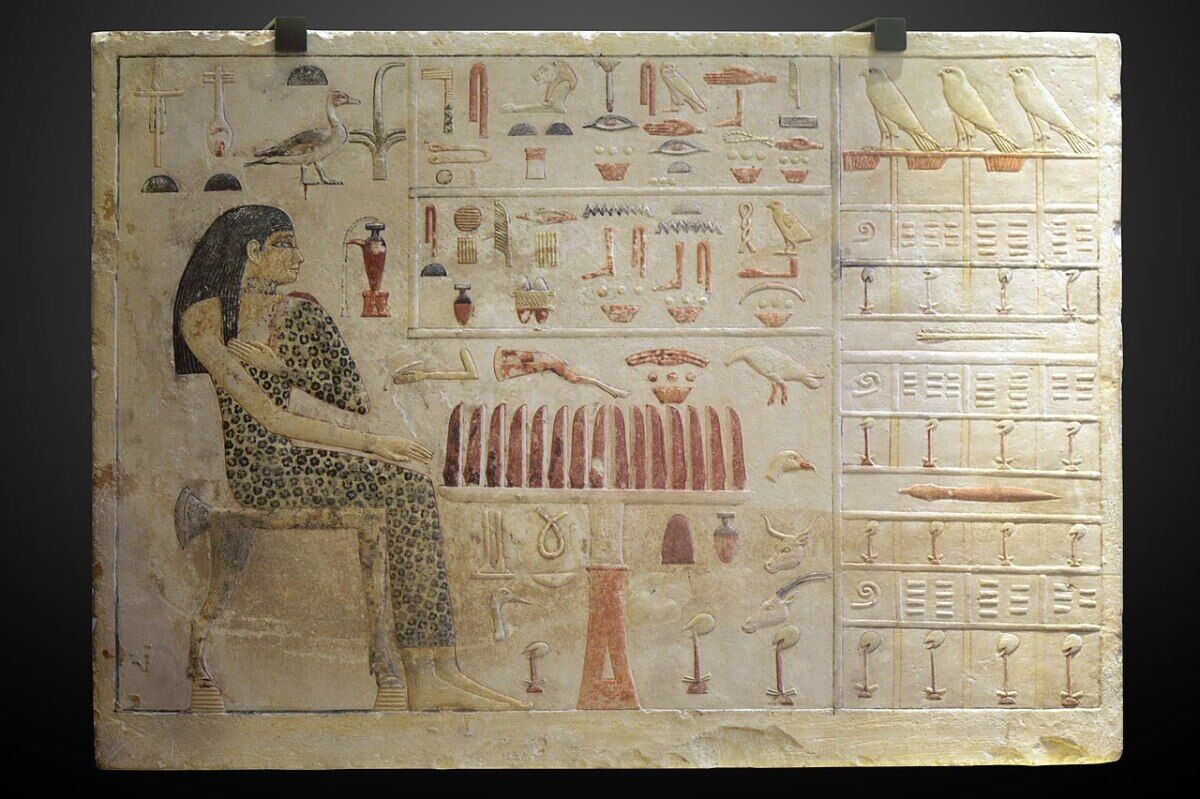
A ‘Pillar At the Border’
Another biblical passage sometimes identified with the Great Pyramid—for example, highlighted by Joseph Seiss and Herman Hoeh—is found within Isaiah 19. “In that day shall there be an altar to the Lord in the midst of the land of Egypt, and a pillar [variously translated as stone pillar, monument or shrine] at the border thereof to the Lord. And it shall be for a sign and for a witness unto the Lord of hosts in the land of Egypt …” (verses 19-20).
Of this verse, Dr. Hoeh writes in his above-quoted article: “[T]he Great Pyramid may be the pillar which Isaiah referred to, and it might be again dedicated in the future as a pillar or monument of witness to what the Eternal—the Amen—will do in delivering Egypt.” Seiss writes, equating both these items (the “altar” and “pillar”) as referring to one and the same monument: “Everything in this prophecy seems to look to the Great Pyramid. It refers to some specific and telling monument, and all its terms most fully apply to this marvellous pillar. There is nothing else known to which they do apply in literal accuracy and fulness. …
The location likewise corresponds. The Great Pyramid is the hub or centre of Egypt’s curved shoreline, and so is “in the midst of the land,” as nothing else to be thought of ever was. Yet it is also “at the border thereof.” It stands on the extreme southern limit of Lower Egypt, and on the natural dividing line between the two Egypts. It is thus doubly “in the midst” and doubly “at the border.” (pg. 49)
Indeed, the Hebrew word for Egypt, Mizraim, refers to the “two lands”—the divide between Upper (southern) Egypt, and Lower (northern) Egypt. Further, the position of the Great Pyramid could also effectively be applied to the border of the territory of Goshen (Lower Egypt) that was given to the ancient Israelites (Genesis 47).
Last But Not Least: The Orion Connection
One final item of note, an astronomical angle. A famous existing theory regarding the layout of the Great Pyramid and its two large nearby pyramids (attributed to Khufu’s son Khafre and grandson Menkaure) is that they were built in deliberate replication of the layout of the Orion constellation—namely, the three famous stars of Orion’s belt (see the image overlay below). This is known as the “Orion Correlation Theory.”

The Orion constellation is actually mentioned three times in the Bible—two of those times in the book of Job. Job 9:9 highlights, again, God as the “Maker of … Orion” (New International Version). And in Job 38:31, God specifically discusses with Job His own power over—not just Orion—but “the belt of Orion” (nkjv). Following this mention of Orion’s belt, God then immediately proceeds to ask Job, in relation to the constellation: “Knowest thou the ordinances of heaven? Canst thou set the dominion thereof in the earth?” (verse 33). Can the mighty heavens be replicated in the stones of the Earth?
A key understanding of astronomy also explains how the Great Pyramid was so perfectly, almost inexplicably aligned to True North (not magnetic north, which regularly changes position). The book of Job contains several references to the North, including the following peculiar statement: “Out of the north he comes in golden splendor; God comes in awesome majesty” (Job 37:22; niv). Alternatively, the New Living Translation puts part of the verse this way: “So also, golden splendor comes from the mountain of God.” (On this point, note that the Great Pyramid’s missing pyramidion is often considered to have been made of gold/electrum.)
The book of Job—and equally, the Great Pyramid—contains quite a detailed understanding of astronomy (among other phenomena)—knowledge that scientists have only recently “discovered” in the last few centuries. For more on that topic, read “The Bible Scoops the Scientists.”
Could all of these astronomical and architectural connections help explain what Job meant in Job 16:19 (kjv), when he said, “my witness is in heaven, and my record is on high”?
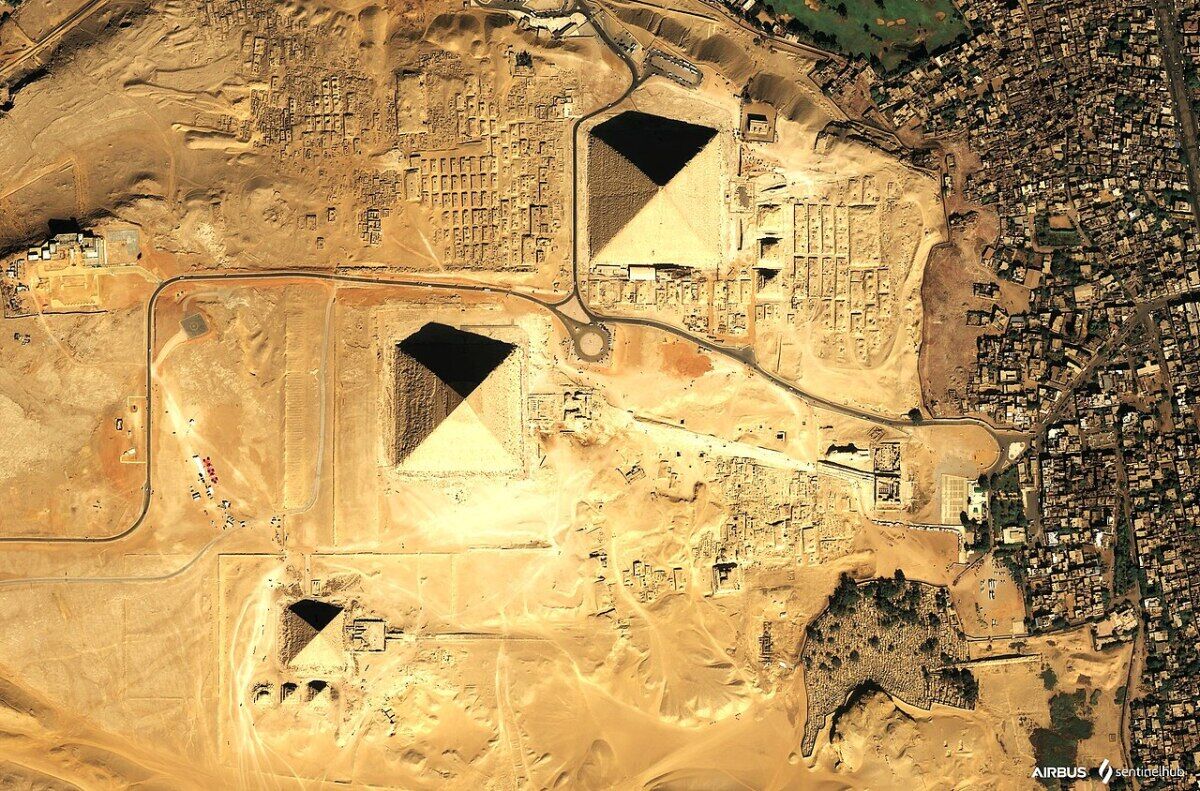
The Conclusion of the Matter
When it comes to such an awe-inspiring, yet confounding, monument as the Great Pyramid, theories will naturally abound—they have for thousands of years, and will only continue to do so (unless and until more definitive discoveries can hopefully be made). Among them are several different Bible-related theories for construction—such as a connection with Joseph, Seth, Job and/or Melchizedek.
The theory that Job, the “greatest man of antiquity,” directed the construction of the Great Pyramid is one of the most intriguing and multifaceted. As concluded by Herbert Armstrong: “[T]here are a great many things in the Great Pyramid that are just beyond belief, almost—it was so perfectly designed. And a great many people believe that the Great Pyramid was divinely inspired. At least, you see things in it that certainly make you wonder. And I will say this: I’m not going to discount the possibility at all.”
“It’s an interesting theory,” he said of Job and the Great Pyramid. “At least, it always has been to me, and I hope it will be to a lot of you.”
